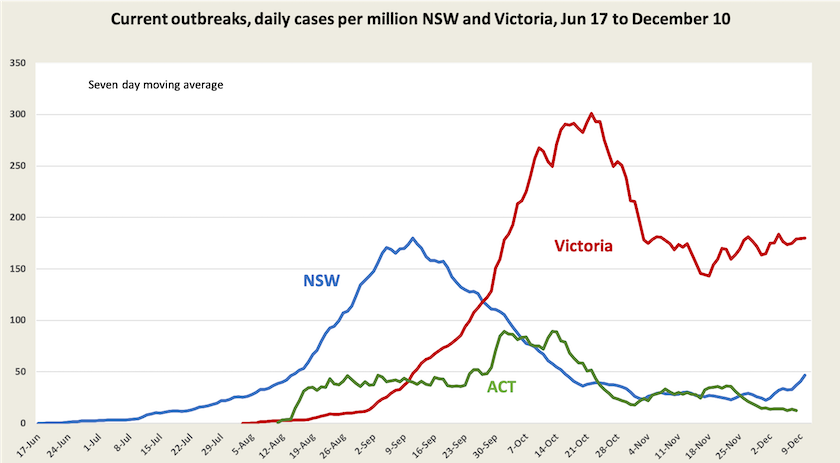The pandemic
Omicron
We still don’t know much about it. If, as is likely, it is spreading faster than earlier variants, it will put a large burden on the world’s health care resources. Even if it generally results in less severe disease, the sheer number of cases could overload countries’ health systems. Prior infection does not seem to provide immunity, and the variant seems to be clever enough to get around some layers of vaccines’ defences.
There is no shortage of posts about Omicron on social media, newspaper websites and so on, but so far they provide very little useful information. Journalists under pressure will grab whatever information they can find; sub-editors and headline writers simplify the content even further, in order to produce a story based on very little evidence. At the other extreme epidemiologists and immunologists, quite reasonably exercising high standards of scientific caution, take a long time to publish their findings. In the time between the media anecdotes and the scientific research there is little to guide policymakers.
We should keep an eye on Coronacast where Norman Swan tries to fill in that gap, while maintaining a high degree of caution and scepticism.
On Thursday’s Coronacast Swan cautiously reports that the Omicron variant seems to be effective at evading antibodies, be they antibodies from vaccines or earlier infections. Based on deductions from laboratory analysis, reported in a yet-to-be peer-reviewed study, he concludes that people with three-dose vaccination should almost certainly be able to resist severe disease.
Covid-19 in Australia
For the last six months living with the pandemic has been a matter only for New South Wales, Victoria and the ACT, as the virus spread from the Sydney limousine driver. The chart below shows recorded case numbers in those jurisdictions.

Three things stand out from the graph.
First, and most obvious, the infection rate is much higher in Victoria that in New South Wales and the ACT. Differences in state-wide vaccination rates are too tiny to have any explanatory power (76.7 percent in Victoria, 77.8 percent in New South Wales). The ABC’s Joseph Dunstan, quoting public health experts, suggests that one reason for the difference is that the virus is more evenly spread throughout Victoria, while it is concentrated in pockets in New South Wales: Why Victoria is still recording hundreds more daily COVID-19 cases than NSW.
Second, in both states, after peaking, after a period of exponential decline, infections stopped falling. This is generally in line with Doherty modelling that shows the importance of the level of infections when controls start to be relaxed. This finding has probably influenced the governments of Queensland, South Australia and Tasmania that are maintaining tough restrictions on interstate arrivals. Queensland has particular reason to be wary, because while vaccination rates are reasonably high in Brisbane, they are comparatively low in the rest of the state, including areas close to Brisbane such as Logan-Beaudesert, and they are very low in the outback.
Third, and of most concern, infections are rising once again in Victoria and New South Wales. The R, or reproduction rate, is above 1.0.[1] So far there is no strong evidence of a rise in deaths in either state. (The daily death rate in New South Wales is around 0.3 per million, which is around the lowest in the world for countries where the virus is endemic, while Victoria’s death rate, around 1.0 per million per day, is in line with the rates in many well-vaccinated countries.) It is far too early to tell if these rises have anything to do with the Omicron variant.
[1] Dunstan suggests that R is about 1.0 in Victoria, but another week’s data suggests it is now > 1.0. ↩
Vaccination
A notable development last week has been the approval of the Pfizer vaccine for children aged 5 to 11. That means that by some time in February or March (allowing for an 8-week gap between first and second shots), 94.0 percent of Australians will be potentially vaccinated, a significant expansion on the 85.1 percent presently eligible.
As at December 8, 74 percent of Australians are vaccinated. In New South Wales, Victoria and the ACT, 78 percent of people are vaccinated: in the other five jurisdictions the level is 68 percent. [2] Several countries, including Portugal, Singapore, Chile, Iceland, Korea and Spain, have achieved vaccination levels between 80 percent and 89 percent.
[2] No state or territory has achieved 90 percent as Morrison and some journalists are boasting, because they are erroneously referring to the vaccination rate among Australians aged 16 and over. The ACT has achieved 83 percent cover, which is about as far as any state or territory can go until younger children and infants are vaccinated. Some countries that have achieved very high rates are vaccinating children, and some, such as Spain and Portugal, because they have a low proportion of children in their populations, will achieve higher rates than we can achieve in the short term.↩